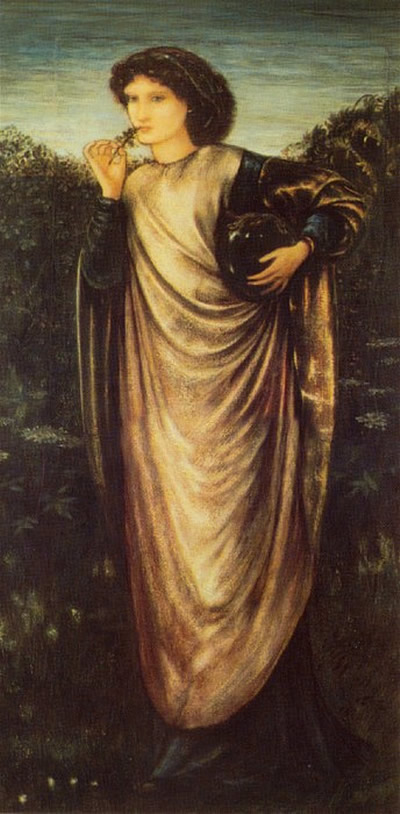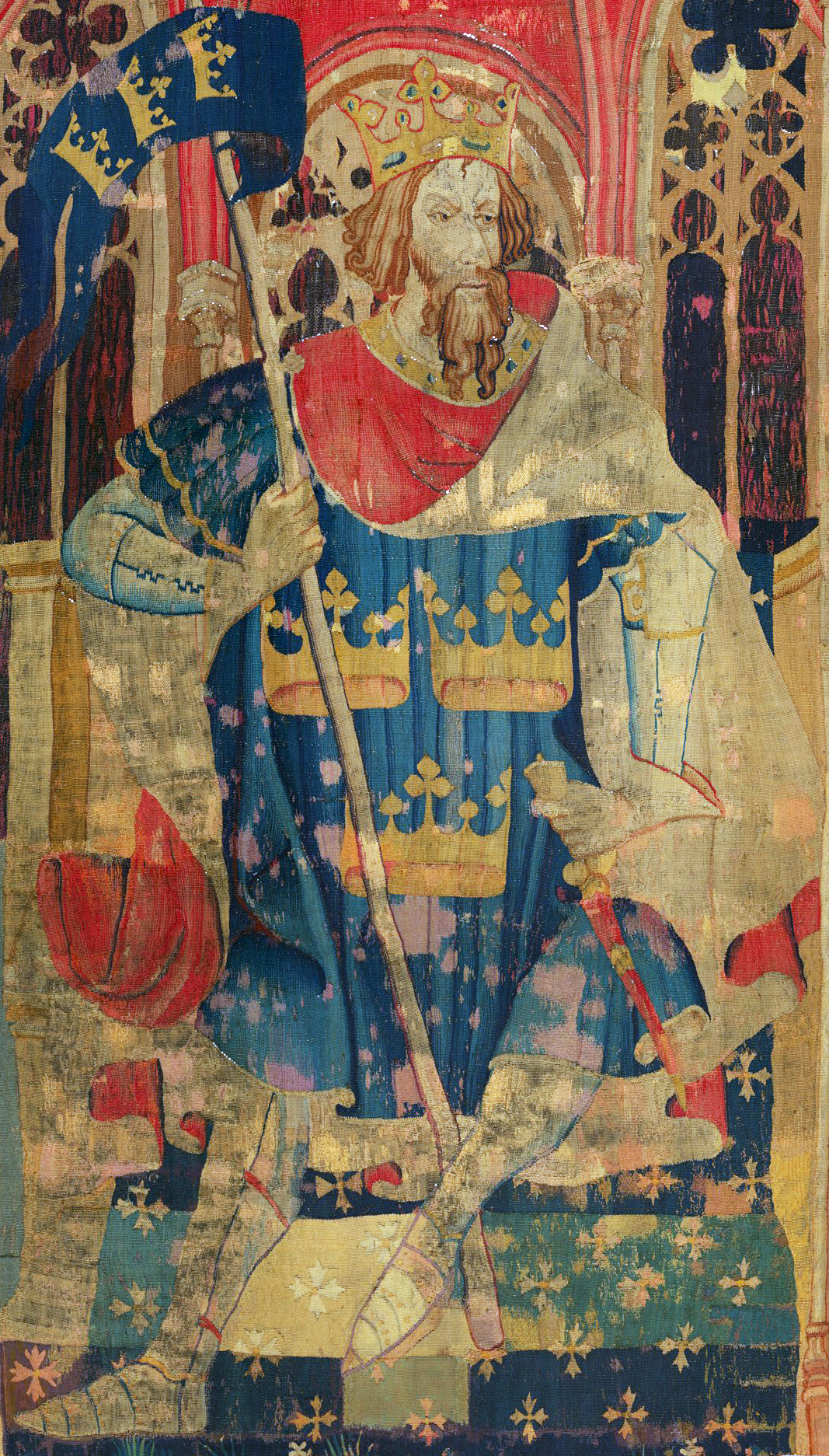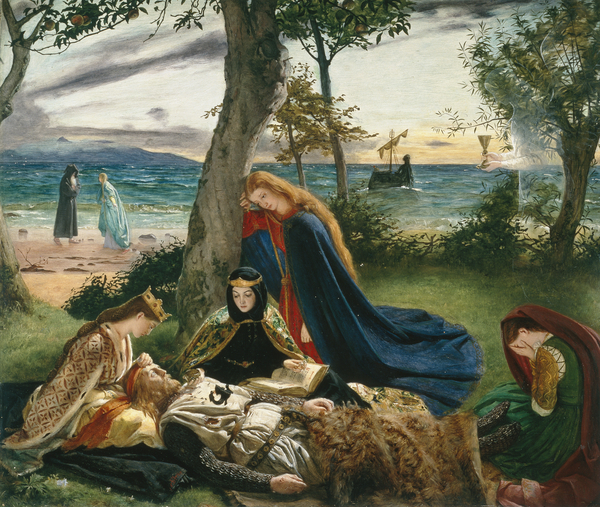|
Emain Ablach
Emain Ablach (also Emne; Middle Irish Emhain Abhlach or Eamhna; meaning "Emhain of the Apples") is a mythical island paradise in Irish mythology. It is often regarded as the realm of the sea god Manannán Mac Lir and identified with either the Isle of Man or, less plausibly, the Isle of Arran. According to the medieval Irish poem ''Baile Suthain Sith Eamhna'', the god Lug Lamfada was reared in Emain Ablach. In another poem from the 14th century, Emain Ablach is described as being filled with swans and yews. Etymology "Emain/Emne" is of uncertain etymology, though it may be compared with the place name Emain Macha in Ireland, recorded as "Isamnion" in Ptolemy's 2nd-century AD Geography, which Celticist Heinrich Wagner would translate as "what is moving by itself rapidly, the stream", derived from the Proto-Indo-European root ''*eis-'' "to move rapidly".Wagner, p. 13. "Ablach" means "of the apples/fruits" in Old Irish. Influence In medieval Arthurian literature, Geoffrey o ... [...More Info...] [...Related Items...] OR: [Wikipedia] [Google] [Baidu] |
Middle Irish
Middle Irish, also called Middle Gaelic (, , ), is the Goidelic language which was spoken in Ireland, most of Scotland and the Isle of Man from AD; it is therefore a contemporary of Late Old English and Early Middle English. The modern Goidelic languages—Modern Irish, Scottish Gaelic and Manx Gaelic—are all descendants of Middle Irish. Grammar Middle Irish is a fusional, VSO, nominative-accusative language, and makes frequent use of lenition. Nouns decline for two genders: masculine and feminine, though traces of neuter declension persist; three numbers: singular, dual, plural; and five cases: nominative, accusative, genitive, prepositional, vocative. Adjectives agree with nouns in gender, number, and case. Verbs conjugate for three tenses: past, present, future; four moods: indicative, subjunctive, conditional, imperative; independent and dependent forms. Verbs conjugate for three persons and an impersonal, agentless form ( agent). There are a ... [...More Info...] [...Related Items...] OR: [Wikipedia] [Google] [Baidu] |
Arthurian Literature
The Matter of Britain (; ; ; ) is the body of medieval literature and legendary material associated with Great Britain and Brittany and the legendary kings and heroes associated with it, particularly King Arthur. The 12th-century writer Geoffrey of Monmouth's (''History of the Kings of Britain)'' is a central component of the Matter of Britain. It was one of the three great Western Literary cycle, story cycles recalled repeatedly in medieval literature, together with the Matter of France, which concerned the legends of Charlemagne and his Paladin, companions, as well as the Matter of Rome, which included material derived from or inspired by classical mythology and classical antiquity, classical history. Its pseudo-chronicle and chivalric romance works, written both in prose and verse, flourished from the 12th to the 16th century. Name The three "matters" were first described in the 12th century by French poet Jean Bodel, whose epic ' ("Song of the Saxons") contains the lines: ... [...More Info...] [...Related Items...] OR: [Wikipedia] [Google] [Baidu] |
Celtic Mythology
Celtic mythology is the body of myths belonging to the Celtic peoples.Cunliffe, Barry, (1997) ''The Ancient Celts''. Oxford, Oxford University Press , pp. 183 (religion), 202, 204–8. Like other Iron Age Europeans, Celtic peoples followed a polytheistic religion, having many gods and goddesses. The mythologies of continental Celtic peoples, such as the Gauls and Celtiberians, did not survive their conquest by the Roman Empire, the loss of their Celtic languages and their subsequent conversion to Christianity. Only remnants are found in Greco-Roman sources and archaeology. Most surviving Celtic mythology belongs to the Insular Celtic peoples (the Gaels of Ireland and Scotland; the Celtic Britons of western Britain and Brittany). They preserved some of their myths in oral lore, which were eventually written down by Christian scribes in the Middle Ages. Irish mythology has the largest written body of myths, followed by Welsh mythology. The supernatural race called the ... [...More Info...] [...Related Items...] OR: [Wikipedia] [Google] [Baidu] |
Máire MacNeill
Máire MacNeill (7 December 1904 – 15 May 1987) was an Ireland, Irish journalist, folklorist and translator. She is best known for her magisterial study of the Irish harvest festival, ''The Festival of Lughnasa'' (1962, 1983). Biography She was born at Portmarnock, County Dublin, the second daughter of historian and political figure Eoin MacNeill and Agnes Moore. After the family moved into the city she attended Muckross Park school. She received her BA in Celtic Studies from University College Dublin in 1925. From 1927 to 1932, she worked as a journalist and then as sub-editor on the Cumann na nGaedheal newspaper, ''The Star''. She also assisted her father with his memoirs.Maureen Murphy: Máire MacNeill. Béaloideas 72, 2004 (Irish Folklore Commission) In 1935, Séamus Ó Duilearga invited her to work for the newly founded Irish Folklore Commission as office manager. She trained in folklore methods at Uppsala University, Sweden, before starting research on the Lughnasad ... [...More Info...] [...Related Items...] OR: [Wikipedia] [Google] [Baidu] |
Afallach
Afallach (Old Welsh Aballac) is a man's name found in several medieval Welsh genealogies, where he is made the son of Beli Mawr. According to a medieval Welsh triad, Afallach was the father of the goddess Modron. The Welsh redactions of Geoffrey of Monmouth's ''Historia Regum Britanniae'', Brut y Brenhinedd, associate him with Ynys Afallach, which is substituted as the Welsh name for Geoffrey's ''Insula Avalonsis'' (Island of Avalon), but this is fanciful medieval etymology and it is more likely his name derives from the Welsh word ''afall'' "apple tree" (modern Welsh ''afal'' "apple", afallen "apple tree"Bernhard Maier, ''Dictionary of Celtic Religion and Culture'' (trans. Cyril Edwards, The Boydell Press, 1997). cf. Proto-Celtic *''aballo-'' "apple"< ... [...More Info...] [...Related Items...] OR: [Wikipedia] [Google] [Baidu] |
Battle Of Camlann
The Battle of Camlann ( or ''Brwydr Camlan'') is the legendary final battle of King Arthur, in which Arthur either died or was mortally wounded while fighting either alongside or against Mordred, who also perished. The original legend of Camlann, inspired by a purportedly historical event said to have taken place in the early 6th-century Britain, is only vaguely described in several medieval Welsh texts dating from around the 10th century. The battle's much more detailed depictions have emerged since the 12th century, generally based on that of a catastrophic conflict described in the pseudo-chronicle ''Historia Regum Britanniae''. The further greatly embellished variants originate from the later French chivalric romance tradition, in which it became known as the Battle of Salisbury, and include the 15th-century telling in '' Le Morte d'Arthur'' that remains popular today. Etymology The name may derive from a Brittonic ''*Cambo-landa'' ("crooked/twisting-enclosure" or "crook ... [...More Info...] [...Related Items...] OR: [Wikipedia] [Google] [Baidu] |
Morgan Le Fay
Morgan le Fay (; Welsh language, Welsh and Cornish language, Cornish: Morgen; with ''le Fay'' being garbled French language, French ''la Fée'', thus meaning 'Morgan the Fairy'), alternatively known as Morgan[n]a, Morgain[a/e], Morgant[e], Morg[a]ne, Morgayn[e], Morgein[e], and Morgue[in] among other names and spellings, is a powerful and ambiguous Magician (fantasy), enchantress from the legend of King Arthur, in which most often she and he are siblings. Early appearances of Morgan in Arthurian literature do not elaborate her character beyond her role as a goddess, a fairy , fay, a Witchcraft , witch, or a sorceress, generally benevolent and connected to Arthur as his magical saviour and protector. Her prominence increased as the legend of Arthur developed over time, as did her moral ambivalence, and in some texts there is an evolutionary transformation of her to an antagonist, particularly as portrayed in cyclical prose such as the ''Lancelot-Grail'' and the Post-Vulgate Cyc ... [...More Info...] [...Related Items...] OR: [Wikipedia] [Google] [Baidu] |
King Arthur
According to legends, King Arthur (; ; ; ) was a king of Great Britain, Britain. He is a folk hero and a central figure in the medieval literary tradition known as the Matter of Britain. In Wales, Welsh sources, Arthur is portrayed as a leader of the Sub-Roman Britain, post-Roman Britons in battles against the Anglo-Saxons in the late-5th and early-6th centuries. He first appears in two early medieval historical sources, the ''Annales Cambriae'' and the ''Historia Brittonum'', but these date to 300 years after he is supposed to have lived, and most historians who study the period Historicity of King Arthur, do not consider him a historical figure.Tom Shippey, "So Much Smoke", ''review'' of , ''London Review of Books'', 40:24:23 (20 December 2018) His name also occurs in early Welsh-language literature, Welsh poetic sources, such as ''Y Gododdin''. The character developed through Welsh mythology, appearing either as a great warrior defending Britain from human and supernatura ... [...More Info...] [...Related Items...] OR: [Wikipedia] [Google] [Baidu] |
Excalibur
Excalibur is the mythical sword of King Arthur that may possess magical powers or be associated with the rightful sovereignty of Britain. Its first reliably datable appearance is found in Geoffrey of Monmouth's ''Historia Regum Britanniae''. Excalibur as the "sword in the stone" functioning as the proof of Arthur's lineage is an iconic motif featured throughout most works dealing with Arthur's youth since its introduction in Robert de Boron's ''Merlin''. The sword given to the young Arthur by the Lady of the Lake in the tradition that began soon afterwards with the '' Post-Vulgate Cycle'' is not the same weapon, but in '' Le Morte d'Arthur'' both of them share the name of Excalibur. Several similar swords and other weapons also appear within Arthurian texts, as well as in other legends. Forms and etymology The name ''Excalibur'' ultimately derives from the Welsh ( Breton , Middle Cornish ), which is a compound of , , and , . Caledfwlch appears in several early Welsh wo ... [...More Info...] [...Related Items...] OR: [Wikipedia] [Google] [Baidu] |
Avalon
Avalon () is an island featured in the Arthurian legend. It first appeared in Geoffrey of Monmouth's 1136 ''Historia Regum Britanniae'' as a place of magic where King Arthur's sword Excalibur was made and later where Arthur was taken to recover from being gravely wounded at the Battle of Camlann. Since then, the island has become a symbol of Arthurian mythology, similar to Arthur's castle of Camelot. Avalon was associated from an early date with mystical practices and magical figures such as King Arthur's sorceress sister Morgan, cast as the island's ruler by Geoffrey and many later authors. Certain Briton traditions have maintained that Arthur is an eternal king who had never truly died but would return as the "once and future" king. The particular motif of his rest in Morgan's care in Avalon has become especially popular. It can be found in various versions in many French and other medieval Arthurian and other works written in the wake of Geoffrey, some of them also linkin ... [...More Info...] [...Related Items...] OR: [Wikipedia] [Google] [Baidu] |
Geoffrey Of Monmouth
Geoffrey of Monmouth (; ; ) was a Catholic cleric from Monmouth, Wales, and one of the major figures in the development of British historiography and the popularity of tales of King Arthur. He is best known for his chronicle '' The History of the Kings of Britain'' ( or ') which was widely popular in its day, being translated into other languages from its original Latin. It was given historical credence well into the 16th century, but is now considered historically unreliable. Life and career Geoffrey was born between about 1090 and 1100, in Wales or the Welsh Marches. He had reached the age of majority by 1129 when he is recorded as witnessing a charter. Geoffrey refers to himself in his as (Geoffrey of Monmouth), which indicates a significant connection to Monmouth, Wales, and may refer to his birthplace. His works attest to some acquaintance with the place-names of the region. Geoffrey was known to his contemporaries as or variants thereof. The "Arthur" in these vers ... [...More Info...] [...Related Items...] OR: [Wikipedia] [Google] [Baidu] |
Old Irish
Old Irish, also called Old Gaelic (, Ogham, Ogham script: ᚌᚑᚔᚇᚓᚂᚉ; ; ; or ), is the oldest form of the Goidelic languages, Goidelic/Gaelic language for which there are extensive written texts. It was used from 600 to 900. The main contemporary texts are dated 700–850; by 900 the language had already transitioned into early Middle Irish. Some Old Irish texts date from the 10th century, although these are presumably copies of texts written at an earlier time. Old Irish is forebear to Modern Irish, Manx language, Manx and Scottish Gaelic. Old Irish is known for having a particularly complex system of morphology (linguistics), morphology and especially of allomorphy (more or less unpredictable variations in stems and suffixes in differing circumstances), as well as a complex phonology, sound system involving grammatically significant Irish initial mutations, consonant mutations to the initial consonant of a word. Apparently,It is difficult to know for sure, giv ... [...More Info...] [...Related Items...] OR: [Wikipedia] [Google] [Baidu] |





